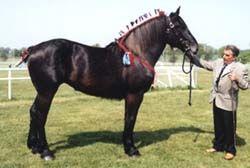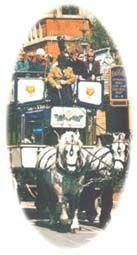 |
The Percheron Horse |
The Percheron Horse originated in the area known as "Le Perche" in the north west of France. Here in 732 A.D. Arabian Horses abandoned by Moors after their defeat in the Battle of Tours were crossed with the massive Flemish stock and from this cross came the Percheron type which has endured for twelve centuries.
During the Crusades, further infusion of Arab blood was made; Arab sires procured in the Holy Land were bred to the Percheron. In the early 1800's the French Government's Stud at La Pin introduced further Arab blood into the Percheron breed by covering selected mares with two outstanding Arab sires. Now all contemporary Percheron's share this common heritage descending from the foundation stock that originated in La Perche. |
 |
The Percheron Horse Society of France was founded in 1883, to safeguard the breeding of pure stock and from this small district of La Perche. Pure-bred breeding stock has been exported all over the world with each nation except U.S.S.R., having an official Breed Association to ensure the preservation of the pure-bred Percheron, and so the Percheron Horse remains genetically pure with registered animals.
Introduction of the Percheron into England came about at the conclusion of the First World War. Many farmers serving with the British Forces in France became familiar with the Percheron and impressed with its docility, activity and power and ability to work both in mud and on hard surfaces. At the conclusion of activities the Percheron was imported to England as a general workhorse and large numbers were to be seen working through out the arable counties of East Anglia and the Fens in particular and they quickly spread to other parts of the country.

The formation of the British Percheron Horse Society took place in 1918 and during 1918-1922, 36 stallions and 321 mares were imported from France and the merits of this clean-legged animal were unmistakably recognised, and membership of the society grew steadily. The main aim of the Society was to encourage the breeding of a clean legged draught horse with short legs, short back, ample bone, powerful, active and quick in work with a good temper and easy to handle.
During World War Two and immediately afterwards, there was a rapid increase in farm mechanisation and a consequent decline in the numbers on heavy horses seen on farms. However, a strong nucleus of Percherons remained on farms in Cambridgeshire, Norfolk, Lincolnshire, Co. Durham, and Hampshire. Enthusiasts have since kept the breed alive and active and now in the 90's with energy crises and oil shortages, there is a tremendous amount of interest in the breed with many new studs being started in various parts of the country. The demand for the Percheron has been such that export sales have been made to Canada, Australia and many other parts of the world to the extent that the Percheron is now a leading breed in the world of Heavy Horses.
Despite the placid nature of the Percheron, they are capable of a good showing with plenty of action when required for showing. A well-matched team of either dark dapple or light greys, properly handled, can make a very fine display. Again, their nature makes them good to handle and very popular with the public.
In recent years pure bred Percheron's have performed well in Heavy Horse Driving Trials and during the "Route de Poisson" where distances of up to 17Km are covered at a trot. Percheron horses crossed with lighter breeds are known to make good riding horses for Hacking and Hunting.
Anyone interested in the draught horse for commercial use would be well advised to give the Percheron serious consideration.
This article and photographs were provided by the British Percheron Horse Society